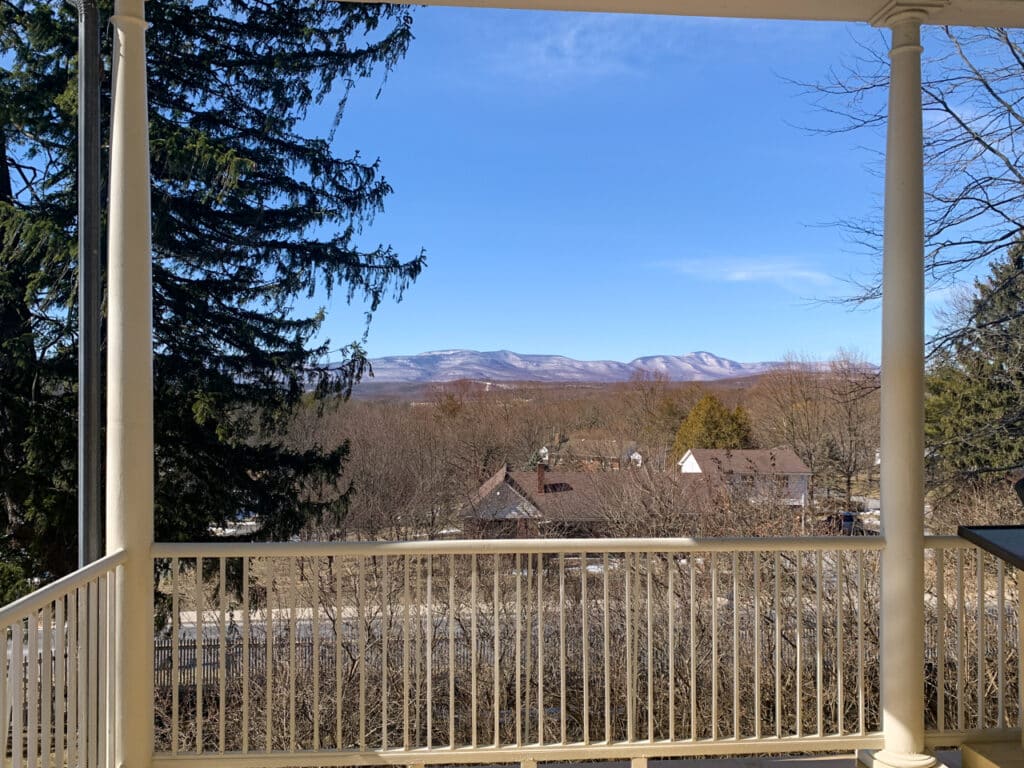
[Updated September 16, 2022] Are you planning to visit Catskill, NY? You should, especially if you’re a fan of nature, art, good food, and locally made craft beer.
The village is not only surrounded by opportunities for outdoor recreation, it was also home to artist Thomas Cole, whose passion for this rugged and magnificent region are plainly apparent in his iconic landscape artworks.
Catskill is also a perfect destination for travelers who love exploring small towns along the Hudson River.
The name “Catskill” bears many burdens. The word itself comes from the Dutch language and means “WildCat Creek.” The village by that name is located within the larger town of Catskill, whose western edge is part of Catskill Park, which in turn is part of the Catskill Mountains of New York State.
Just to get more traction out of the name, Catskill Creek flows through the village, practically splitting it in two.
This article mainly refers to the village of Catskill, NY, which is located in Greene County and is about 120 miles north of New York City and 40 miles south of Albany.
Catskill bears a resemblance to other nearby small towns like Tannersville and Ellenville in that it’s pedestrian-friendly and loaded with cool small businesses and friendly people.
Read on for some history and top Catskill, NY attractions, and to find out many reasons why you should visit this lovely little village in Upstate New York. I hope this also gives you tons of ideas for things to do in Catskill.
1. Catskill has a long and storied past

Early inhabitants of the land that is now the village of Catskill were the Mohicans, a Native American tribe who commonly built their homes near rivers in order to take advantage of the resources water provided.
Henry Hudson first arrived in New York in 1609 and by 1614, the Dutch had set up a fur trading post in this region, which reduced the availability of furs and created problems between the Mohicans and Mohawks, a tribe located further west. Through a combination of European colonialism and the conflicts it created through resource exploitation, the Mohican people were forced out of the region.
Another strong influence on Catskill’s identity is a story about a likeable but lazy guy named Rip Van Winkle, who spent his days avoiding:
- work
- his ever-nagging wife
One day, he and his dog Wolf wandered up into the Catskill Mountains and after a strange encounter, Rip fell into a deep sleep. When he awoke, Wolf was gone.
Back in town, no one knew him and even his children and long-suffering wife seemed to have vanished. We learn at the same time Rip does that his mountainside nap was actually a 20-year deep sleep, during which time his whole world had changed.
Like this post? Pin and save for future reference!

Written in 1819 by Washington Irving, the story of Rip Van Winkle’s long nap was so popular and is still so pervasive in American culture that even now, more than 200 years after its publication, his name and likeness still pop up everywhere, and especially in these parts.
By 1825, the Catskills were already a popular tourist destination when young artist Thomas Cole began capturing the region’s beauty through his now famous landscape paintings, attracting even more tourists to the area. See more on Thomas Cole and his relationship to Catskill, NY below.
At the same time, Catskill’s location on the Hudson River led to its development as a booming port town. Tourists riding steamboats up the Hudson would disembark here and then take a stagecoach or train to their mountain holiday destination.

When you visit Catskill, NY now, particularly when you stroll down Main Street, you’ll see signs of Catskill’s past mixed in with its revitalized present. Churches, storefronts, and inns built as early as 1785 mingle with colorful street art, chic restaurants, and hip cafes. See below for more information on Main Street.
2. America’s first major art movement was born here
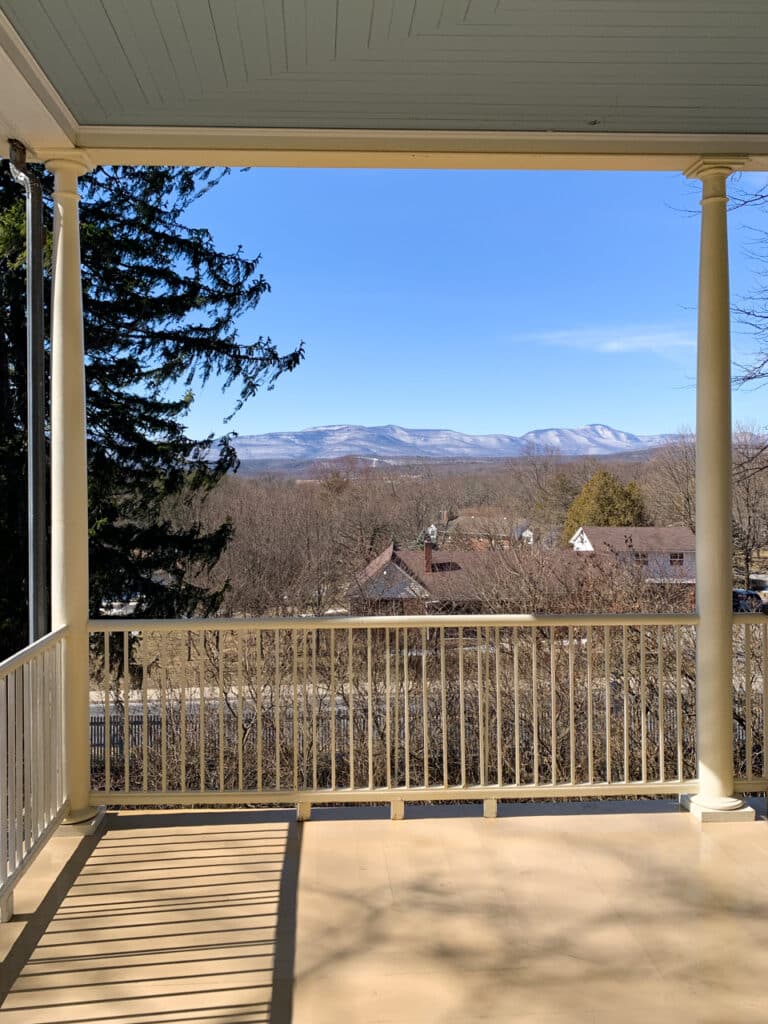
Have you heard of the Hudson River School? The Catskills region was so inspiring to landscape artists like Thomas Cole that it ignited the first major art movement in America.
In 1818, Cole (1801-1848) and his parents arrived in the United States, having fled the poverty and pollution that made up their lives in England. Cole had been an apprentice engraver back home but after the family settled in Philadelphia, he began following a different path.
Cole traveled around Western Pennsylvania and Ohio, painting the portraits of anyone who would pay him to do so. When he was 24, he made the bold decision to move to New York City and started painting landscapes, a genre of art that really wasn’t known in the United States at the time.
After his arrival in New York, Cole traveled up the Hudson River by steamship and into the Catskill Mountains. The views greatly impressed him and he made a series of landscape paintings that ended up gaining him recognition among established artists.
In a nutshell, this was the beginning of the Hudson River School, an aesthetic and philosophical movement that eventually counted over 100 artists who were influenced by Cole’s awe-inspiring depictions of nature.
His now iconic landscape paintings feature pastoral scenes, waterfalls, and vast wildernesses. In addition, Cole was aware, after witnessing how the Industrial Revolution had ravaged the land in his home country, of how quickly humans can destroy these idyllic landscapes.
He used his paintings as a means of warning America, a young country with untouched natural resources ripe for exploiting. Cole believed humans could live in harmony with nature, but that we were were also quick to damage it.
Read on for ways to learn more about Cole’s life, his art movement, and how you can follow in his footsteps on the Hudson River School Art Trail.
Visiting the Thomas Cole National Historic Site
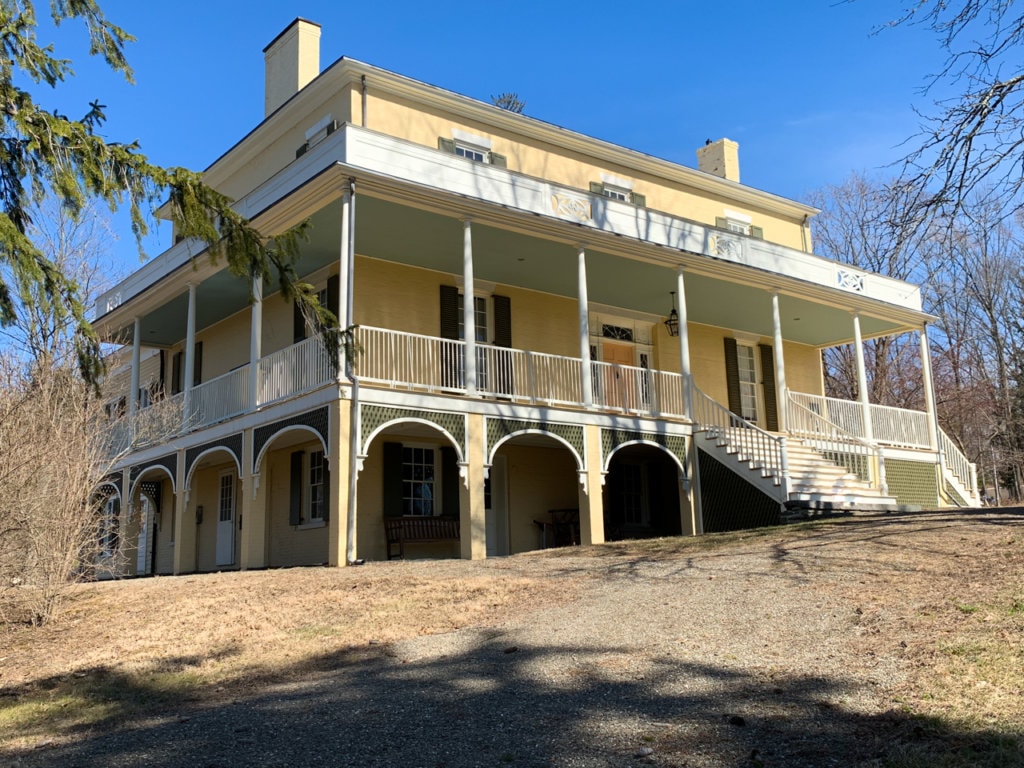
Cole’s home in Catskill is located just a half mile away from Main Street and is part of the National Park Service. Visitors can tour the home where Cole lived with his wife and children and the studios where he painted his masterpieces.
You can also gaze out at the views from his property, which will make you feel as if you’re looking at one of his famous works of art.
Tickets are available for weekday guided indoor tours and weekend general admission. Hours vary by the season. Advance registration is recommended but not required.

Below is a short timeline of Cole’s life in Catskill:
- 1825 – Traveled to the Catskills and produced paintings of the region’s wilderness
- 1832 – Rented an art studio at an estate called Cedar Grove
- 1836 – Married Maria Bartow. The couple moved into Cedar Grove, which is now the Thomas Cole Historic Site.
- 1848 – Died at home unexpectedly at the age of 47. Cole, along with his wife and family, are buried in the Catskill Village Cemetery, just a few minutes away from the home.
The grounds are free and open to the public every day from dawn to dusk. There’s a very informative Grounds Explore Guide available online to lead you around and tell you what you’re looking at.
As a final interesting note: A number of women were artists of the Hudson River School. Because they lived against the grain of society at the time, they and their works did not become well-known.
The Thomas Cole Historic Site has done extensive research on these women and a 2021 lecture on the topic is available on YouTube.
218 Spring Street, Catskill, 518-943-7465
Following the Hudson River School Art Trail

The Hudson Valley and Catskill Mountains were such prolific subjects for the Hudson River School artists that an established trail known as the Hudson River School Art Trail, now meanders through the mountains, meadows, and streams of the region. The art trail allows viewers to stand inside the landscapes that these artists made so iconic.
A website dedicated to the art trail provides several suggested itineraries.
The One-Day Highlights Tour begins at the Thomas Cole Historic Site. To follow this itinerary, look for the trail near the parking lot that leads to the Hudson River Skywalk (aka Rip Van Winkle Bridge), a mile-long bridge that crosses the river into the city of Hudson. It then leads up to the Olana Historic Site, which is the estate of another prominent Hudson River School artist.
Visiting at least a couple of these scenic destinations should be on your list of things to do in Catskill, NY.
Visiting Olana Historic Site

Also on the Hudson River School Art Trail is Olana Historic Site, former home of Frederic Edwin Church.
Church (1826-1900) studied under Thomas Cole from 1844-1846 and eventually gained almost a celebrity status for his masterpieces.
He achieved this status with his 1859 masterpiece, Heart of the Andes. The oil painting is five feet high by ten feet wide and depicts an Ecuadorian wilderness so vast and wild that when it was unveiled to the public in New York City, people stood in line for hours to see it.
In 19th century America, people had never seen images of nature so vivid.

Church’s home in Hudson, NY, named Olana, sits high on a hill with sweeping views of the Hudson River and the Catskill Mountains. The home itself reflects Church’s love of travel and was influenced by Victorian design and Middle Eastern villas. Calvert Vaux, one of Central Park’s architects, helped Church design the home.

Visitors can tour the Main House, where Church lived with his wife and children. On display are the family’s paintings, sculptures, and furnishings, as well as artifacts they collected during their extensive travels around the world.

The walk from Thomas Cole’s home to Olana is three miles long and involves quite a lot of walking uphill once you reach the Olana estate so you may opt to drive instead.
If you want to keep following the Hudson River School One-Day Highlights Tour, you’d continue on to Kaaterskill Clove and then end at Kaaterskill Falls. Matt and I had previously been to these places, so we skipped them this time.
We did walk from Cole’s house to the Hudson River Skywalk but because it was a chilly late-winter day and icy winds were blowing across the bridge, we decided to drive to Olana. If you want to walk out a little way onto the bridge, Hudson River Skywalk Parking is available at the beginning of the bridge on the Catskill side. 5720 State Route 9G, Hudson, NY
3. You’ll be charmed by the village Main Street
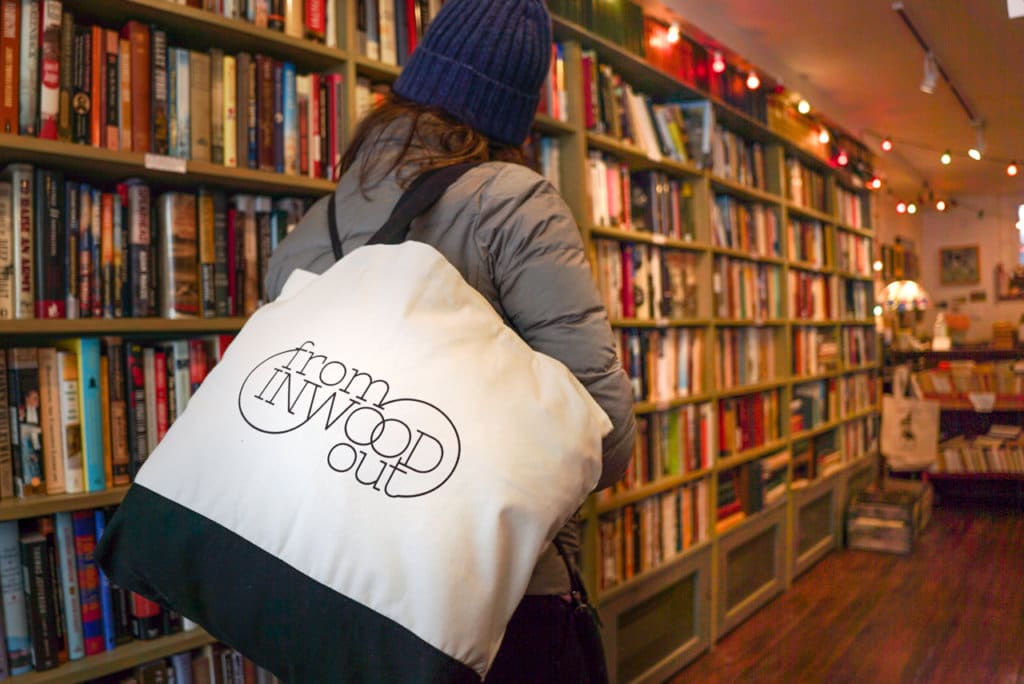
Everything comes together on this small strip of Main Street in Catskill, where we spent an unexpectedly long time window shopping and browsing around the many shops and boutiques.
Catskill is a lot like other nearby towns in its eclectic mixture of local businesses. A few stores we spent some time in were Magpie Bookshop, Spike’s Record Rack, and Mahalo Gift Shop. And while we don’t have a cat, I loved the looks of Cat on the Corner, a cat-themed giftshop.
Be sure to check out CREATE Council on the Arts, formerly Greene County Council on the Arts. This community arts center supports local and emerging artists in Greene and surrounding counties. Visitors can view rotating exhibits at their location on Main Street or attend an event within the local community. Check their events calendar to keep up on the latest exhibits and performances.
The period architecture adds another layer of interest to the village of Catskill. There are churches of various denominations, some dating back to the mid-1800s, an Art Deco building from 1930, and Greene County Courthouse, built in 1910. Main Street is also where many cafes and restaurants are located.
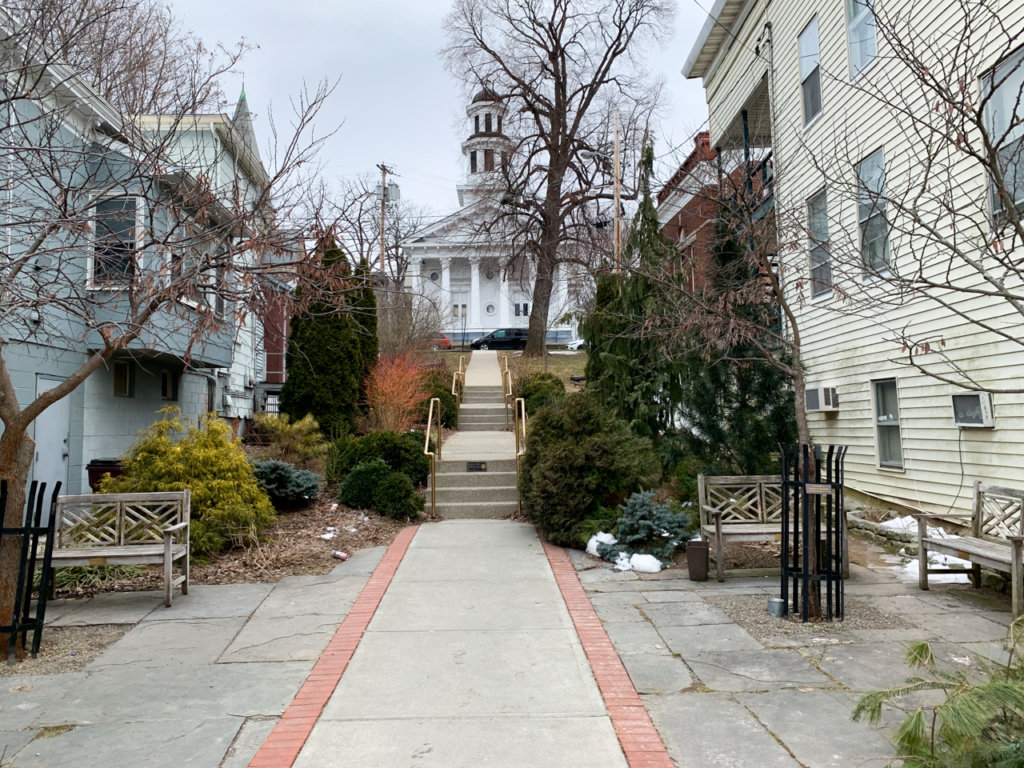
TIP: At the corner of Bridge Street and Main Street, there is a sign indicating a Walking Tour of Historic Main Street. The sign has a list of 20 buildings along Main Street and gives the date they were built. When you visit Catskill, NY, this is a great way to orient yourself to the village sites and architecture.
4. You can sample craft beer at excellent Catskill breweries

For craft beer aficionados, visiting local breweries must be at the top of your list of things to do in Catskill, NY.
Only a handful of breweries and wineries make up the Catskills Beverage Trail but at least three of the businesses are local Catskill breweries. Rip Van Winkle Brewing Company, in addition to serving up comfort food, also has seven in-house brews and a history of beer-making that goes back to 1996, when the same family opened the popular Hyde Park Brewing Co. (which sadly closed in 2022).
Crossroads Brewing Company and Catskill Tap Room is located on the banks of Catskill Creek in what used to be a newspaper printing facility. In 2020, this Catskill brewery was named as the Best Place to Have a Craft Beer in the Best of Greene County Competition.

On our way to dinner one night, we stopped at Subversive Malting & Brewery where we drank a Table Saison and a New York IPA in their “Winter Camp,” in which two large hunting tents were set up in a beer garden with fires crackling away in the woodstoves to keep things warm and cozy. They also had a couple of outdoor firepits going.
Catskill is also home to Left Bank Ciders, a cidery and tasting room serving small batch ciders and meads.
Beer lovers, you owe it to yourselves to put the breweries in Catskill, NY at the top of your itinerary!
5. You can dine at interesting local restaurants
“Make pierogi, not war.”
If this is the energy you want from Catskill, NY restaurants, then I recommend New York Restaurant, where the servers wear this slogan on their T-shirts. This imperative is backed up with some pretty delicious homemade pierogi and as someone who grew up eating these savory dumplings of Eastern European origin, I was an immediate fan.
Additional menu items also lean toward this region’s cuisine and if that’s your pleasure, then I highly recommend the Tour of Poland, a dish which comes with golabki, potato and cheese pierogi, and kielbasa and sauerkraut.
If you’re at all a fan of Polish cuisine, you will leave here a happy person.
Plenty of classic American fare such as ribeye steaks, roasted chicken, and pan seared scallops are also on the menu.

Each meal we ate at the restaurants in Catskill, NY was memorable.
We arrived in town hungry and decided on lunch at La Casa Latina Mexican and Latin Restaurant. We ate fish tacos with mango salsa and had fresh warm nachos and ice-cold beers on the side. We also had a nice chat with the friendly owner.

Dinner that night was at Rip Van Winkle Brewing Company, the place for pub style comfort food like burgers and steak sandwiches. Our view from the bar had us looking in the direction of the brick-oven and from the looks of the constant pies going in and out of the oven, this is also the hot spot for local pizza.
The next day’s lunch was Thai food at Wasana’s. The Pad Kee Mou and and Tom Yum were as good as any we’ve had anywhere (outside of Thailand, of course!).
We did miss out on a few well-rated Catskill restaurants that I wanted to try, either because our days and meals were limited or because the restaurant was closed for a short break at the time of our visit. These include The Avalon Lounge, HiLo Catskill, La Conca D’oro, and Mermaid Café.
Plan to be extremely well-fed on your visit to Catskill, NY. Oh, and for dessert, there’s Cone-E Island Ice Cream, just across Catskill Creek.
6. You can walk on nature trails that resemble landscape paintings
There are tons of opportunities for hikes and nature walks near Catskill, NY. We visited in early March, a time of year when many trails haven’t fully opened yet. It was also a weekend when it was muddy and icy at the same time—a terrible combination for any sort of real hiking.
Instead, we opted to take leisurely nature walks on trails with rich historical backgrounds, expansive views, and abundant wildlife. We even found ourselves inside yet another of Thomas Cole’s favorite landscapes.
Kaaterskill Falls

If you’re looking for things to do near Catskill, NY, this one is worth the drive!
Thomas Cole’s paintings of Kaaterskill Falls are so vibrant with color and movement that viewing one of them makes an actual trip to the 260-foot falls even more exciting. For me, seeing the landscape through Cole’s eyes adds a layer of aesthetics and complexity, especially when I know how he expressed his concern for the environment through his paintings.
So, when it comes to hikes or nature trails, I strongly recommend Kaaterskill Falls if you haven’t already been. It’s a stop on the Hudson River School Art Trail, and it’s less than a 30-minute drive from Catskill. For more information on how to get there, where to park, and what to do nearby, read my post on Kaaterskill Falls. Laurel House Road, Palenville
North-South Lake

Just a few minutes drive from Kaaterskill Falls, you’ll encounter some of the most stunning panoramic views in all of the Catskills at North-South Lake Campground. During the summer, swimming, boating, and camping are popular activities at North-South Lake. But be sure to leave some time to hike the trails, several of which are stops on the Hudson River School Art Trail.
Read more about trails at North-South Lake here.
Mawignack Preserve
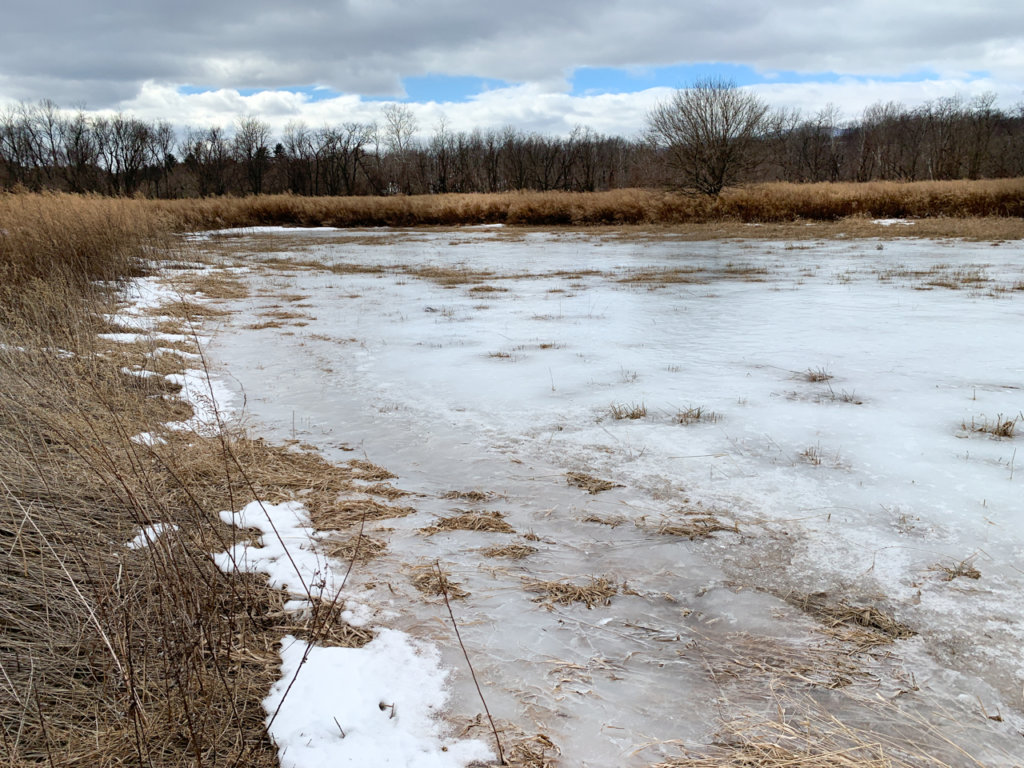
The name means “place where two rivers meet” and refers to the coming together of Catskill and Kaaterskill Creeks. The Mohican people lived here for thousands of years before the Europeans arrived.
Interpretive signs along the trail tell the story of Pewasck, a female leader of the Mohicans, who signed a deed with a Dutchman in 1649. In return, she received “course woolen cloth, a beaver jacket, and a knife.”
Similar to the story of Peter Stuyvesant and his (in)famous purchase of Manhattan for 60 guilders, it is likely that Pewasck and her son believed they were working out a shared arrangement of the land with the European settlers. However, they were ultimately forced to leave their land.
Mawignack Preserve is also part of the Hudson River School Art Trail and a landscape that Thomas Cole painted several times over. It’s a peaceful nature reserve with meandering paths through meadows and creek—the perfect spot for a mindful stroll or some wildlife spotting.
An online trail map is available, outlining a one-mile loop trail around the preserve. Dogs on leashes are permitted. 52 Snake Road, Catskill
RamsHorn-Livingston Audubon Sanctuary

This is a perfect place to walk your dog, do some birdwatching, or simply stretch your legs and get some fresh air. A freshwater tidal swamp on the Hudson River makes up the landscape here and there are easy half-mile trails you can follow that meander around various paths through this 460-acre bird and small animal habitat.

From the parking lot, we set out on the Old Farm Trailhead, a straight and narrow path lined with dense woods that eventually opens up to a swampy marsh. We climbed the four-story overlook tower for panoramic views. Even though we missed out on the thick green foliage and color wildflowers of spring, the clear blue-sky day still delivered stunning views.
The additional three trails (Red, Blue, and White) then continue on past the Old Farm Trailhead and form kind of a bucolic loop—you could do all of them in short time with relative ease. You’ll also find a platform that you can view the marsh from and a canoe and kayak launch from which the Hudson River can be accessed.

If you have an interest in birdwatching, you’re in luck. All kinds of birds pass through here. Superstars include bald eagles, great blue heron, osprey, blue jays, hummingbirds, and the common loon. Be sure to download the RamsHorn birdwatching checklist before you go.
RamsHorn-Livingston Audubon Sanctuary offers summer guided canoe trips. For more information, call 845-265-2601 (ext. 102) or email cmacs@audubon.org.
Dogs on leashes are allowed on the trails. 84 Dubois Road, Catskill
Dutchman’s Landing Park
If you’re seeking a typical park by the river, head to Dutchman’s Landing Park, so named to mark where Henry Hudson and his crew aboard the Half Moon stopped in 1609.
The park has BBQ’s, a playground, boat launch ramps, and a summer concert series. The location on the Hudson River offers beautiful views.
How to Get to Catskill, NY
Catskill is located at exit 21 off of I-87. Amtrak trains stop across the river in Hudson, so you’d need to rent a car or take a taxi or car service from there. The nearest major airport is Albany International Airport, approximately 40 miles away from Catskill.
Like this post? Pin it and save for future reference!


Great representation of our village- recently moved here & lovin’ it!
I loved the village! It must be a great place to live.
Village of Catskill is an undiscovered jewel. It has been enjoying a comeback to its former heyday…one of the summer traditions is “Cat n’ Around” Catskill Cats. There are large resin cats decorated with a theme of the business who sponsors the Cat. Cats are displayed on a stand placing them at eye level on Main Street. Last year the Cats expanded to different locations in the village.
It costs nothing to view the kitties and is lots of fun to see the themes.
This sounds very cool! I would love to see Main Street in all its cat-glory. Thanks for letting me know about this!
I lived in Catskill as a youth growing up and into my adult years. It was a quaint, rural area. Sadly it has lost the small-town atmosphere and now is becoming a haven for people escaping the city. Too many antique shops and art places and not enough small-stores like when I grew up. No longer a newspaper stand (like Kleins) or a small luncheonette (Bill’s) or grocery stores (like Joe DeCicco’s). No friendly neighborhood ice cream hang-out (Mayflower). No five-and-dime store where you could find anything and get a soda at the same time (Newberry’s). Those are what made Catskill special. No more Old Catskill Days.
I’m sure there must be a lot of changes in Catskill compared to when you grew up there! I wish I could have seen it then. From my perspective of not growing up there, I do think it still holds a special small-town charm.